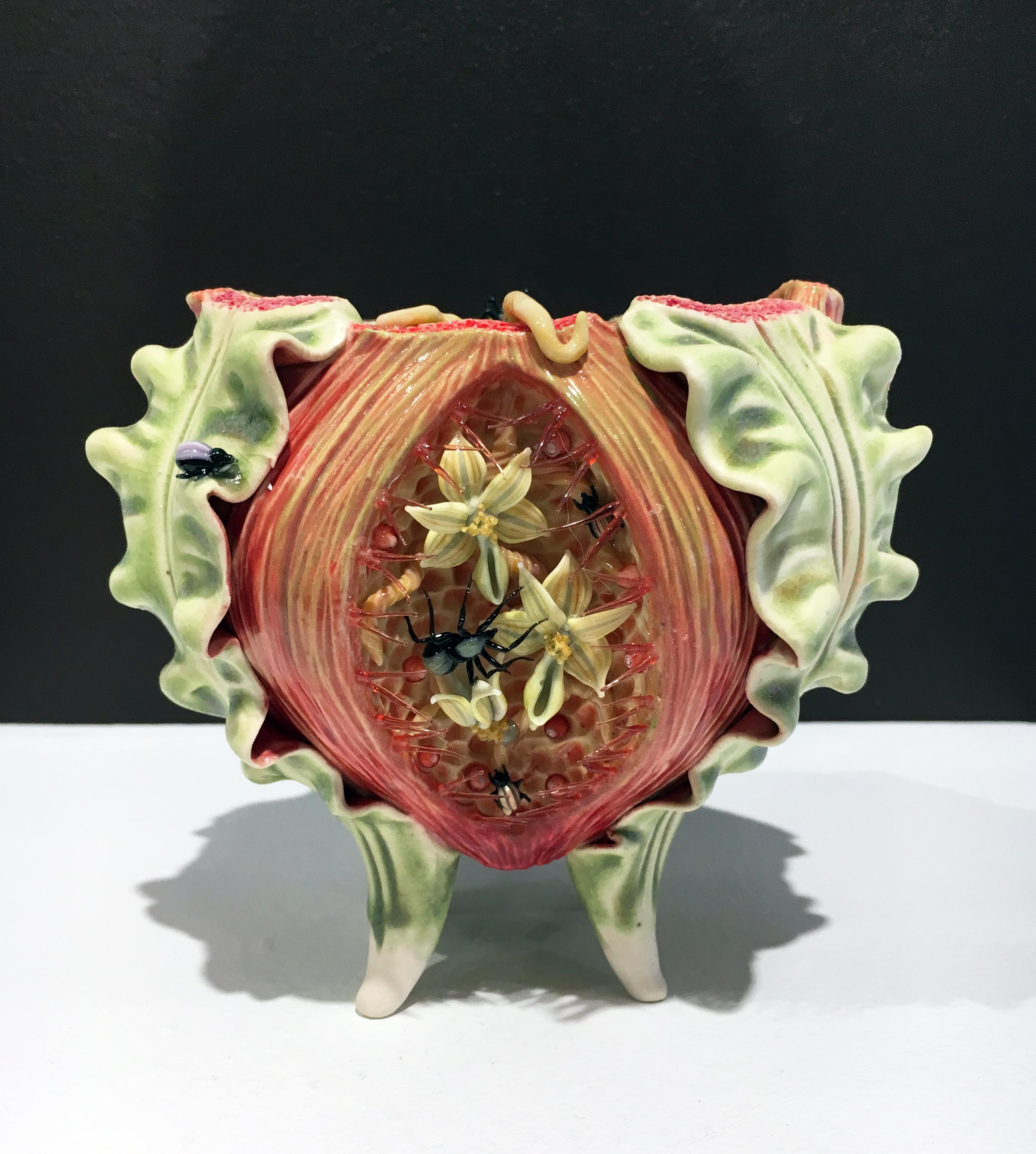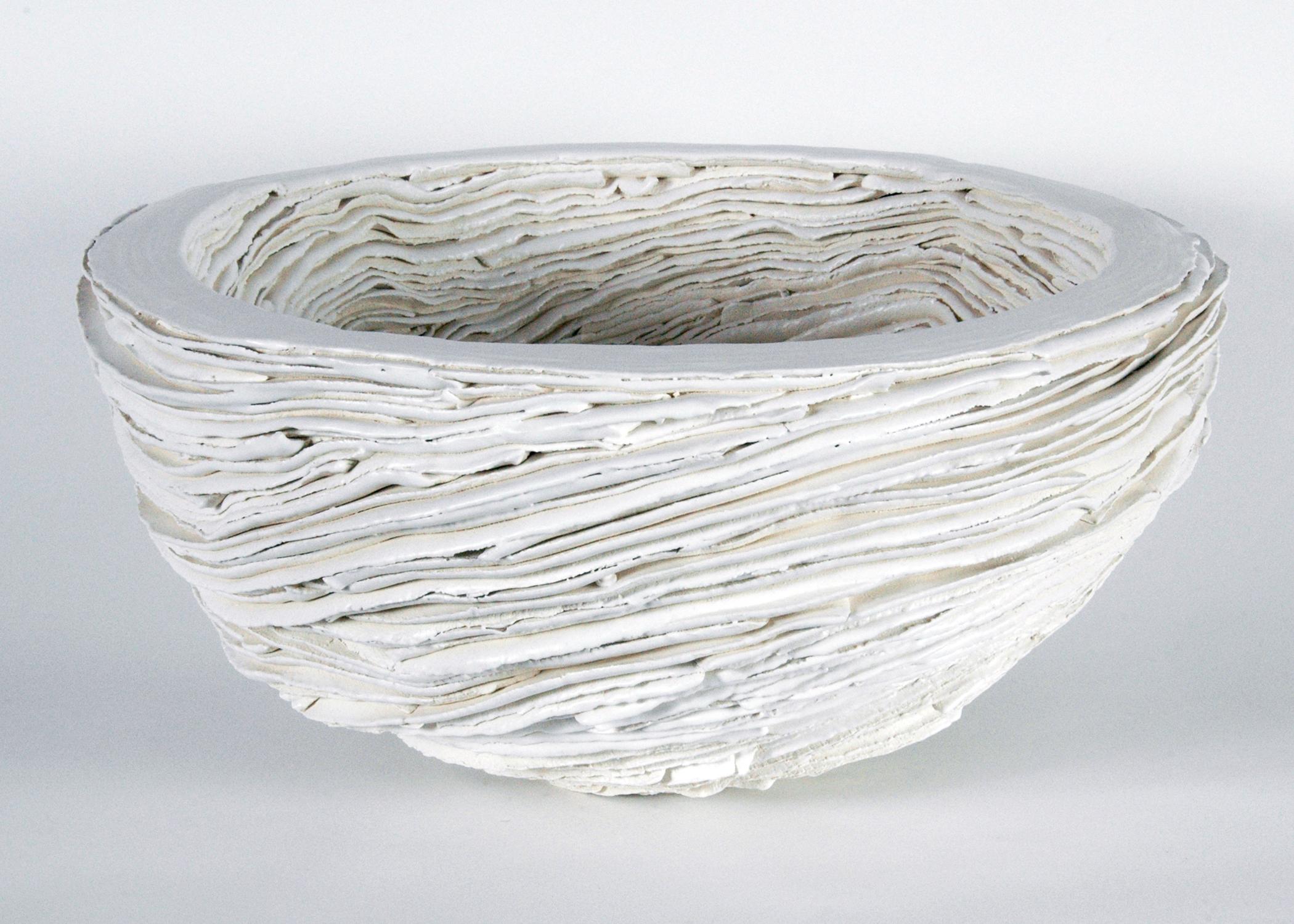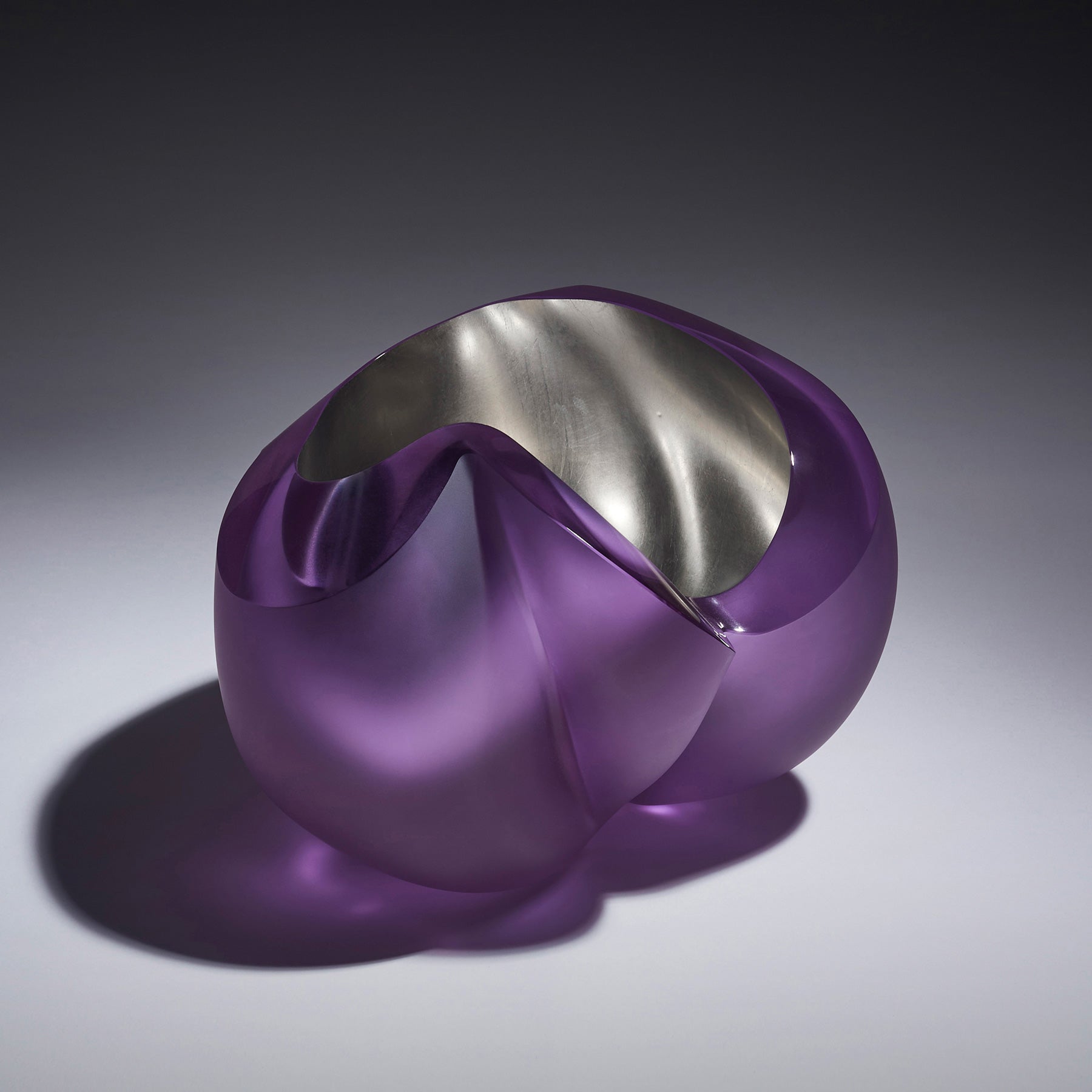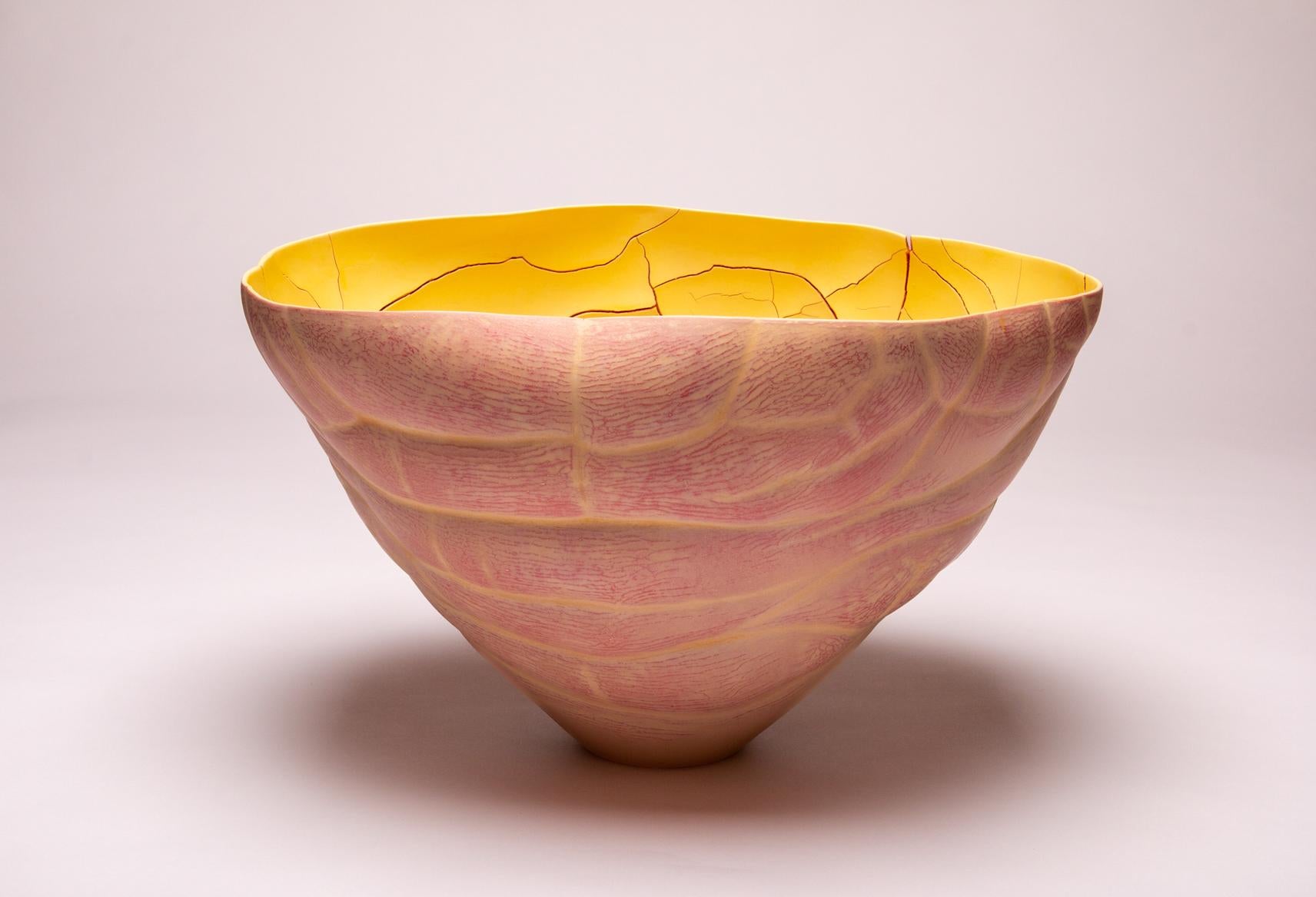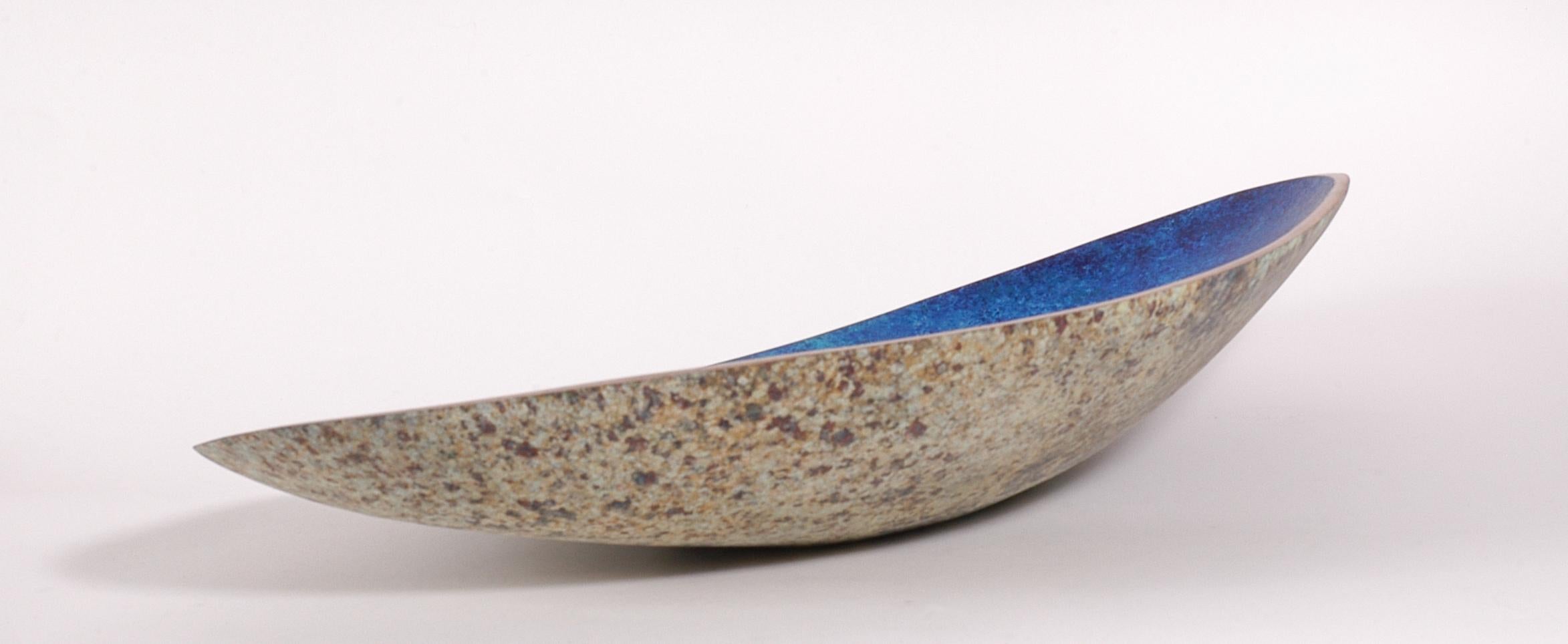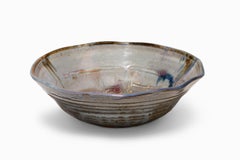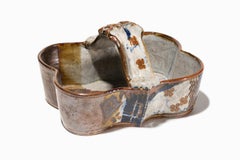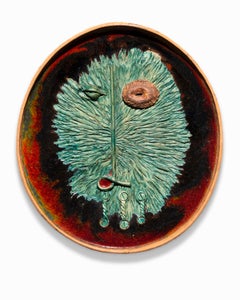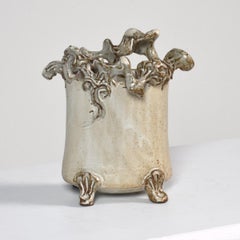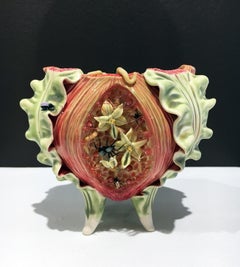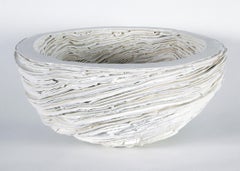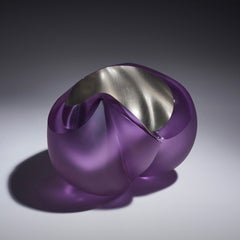Items Similar to John Albert Murphy Porcelain "Dark Days Ahead" Sculptural Nested Bowls
Want more images or videos?
Request additional images or videos from the seller
1 of 10
John Albert MurphyJohn Albert Murphy Porcelain "Dark Days Ahead" Sculptural Nested Bowls2016
2016
$3,000
£2,264.02
€2,591.96
CA$4,230.99
A$4,645.10
CHF 2,423.36
MX$56,212.23
NOK 30,373.07
SEK 28,619.42
DKK 19,348.27
About the Item
"Dark Days Ahead" is in fact a glorious paper-thin porcelain sculpture with fluted sides. The "two bowls and one ball" are nestled and permanently fixed. The black and white linear design to the porcelain is relieved by the movement of the fluted sides of the "bowls." This complex design is both light and airy while being visually weighted by the innermost "ball" being covered in a silver glaze suggesting heavy stainless steel. The ceramic piece is slip cast porcelain, masking tape stenciled and glazed in the style of abstract expressionism, specifically Pointillism. It was fired in oxidation at 2230 degrees Fahrenheit. The sphere in the center has luster glaze.
John Albert Murphy heads as the Director the Ceramic Arts Department, the Birmingham Bloomfield Art Center. Murphy takes the reins at the BBAC after working more than 33 years as a program analyst at Ford Motor Co. While carving out a career in manufacturing, Murphy never stopped working in his preferred medium -- clay. His love affair with clay started in his first class with Gawaine Dart at Henry Ford Community College in 1968. Murphy has been teaching ceramic arts since 1986 as an Adjunct Instructor at Wayne County Community College; Henry Ford Community College; Schoolcraft College and Wayne State University.
He holds a Master of Fine Arts degree from Wayne State University, and a BFA from Eastern Michigan University in Ypsilanti. Some other well- known artists who attended Wayne State University are: Arthur Danto, Dr. Wayne Dyer, Tyree Guyton, Hughie Lee-Smith, Philip Levine, Casey Kasem and Helen Thomas.
He is accomplished in all aspects of ceramics, from hand building to wheel throwing and from Raku firing to cone-10 reduction firing in a downdraft kiln. His works can be found in collections as far away as Australia, China, South Korea, Switzerland, and Taiwan. He is currently Program Director of the Michigan Ceramics Art Association, past President of Michigan Potters' Association (1992-93), and member of the National Council on Education for the Ceramic Arts.
- Creator:John Albert Murphy (1950)
- Creation Year:2016
- Dimensions:Height: 4 in (10.16 cm)Diameter: 9.25 in (23.5 cm)
- Medium:
- Movement & Style:
- Period:
- Condition:
- Gallery Location:Detroit, MI
- Reference Number:1stDibs: LU128615465662
About the Seller
5.0
Vetted Professional Seller
Every seller passes strict standards for authenticity and reliability
Established in 2014
1stDibs seller since 2019
108 sales on 1stDibs
Typical response time: 17 hours
- ShippingRetrieving quote...Shipping from: Detroit, MI
- Return Policy
Authenticity Guarantee
In the unlikely event there’s an issue with an item’s authenticity, contact us within 1 year for a full refund. DetailsMoney-Back Guarantee
If your item is not as described, is damaged in transit, or does not arrive, contact us within 7 days for a full refund. Details24-Hour Cancellation
You have a 24-hour grace period in which to reconsider your purchase, with no questions asked.Vetted Professional Sellers
Our world-class sellers must adhere to strict standards for service and quality, maintaining the integrity of our listings.Price-Match Guarantee
If you find that a seller listed the same item for a lower price elsewhere, we’ll match it.Trusted Global Delivery
Our best-in-class carrier network provides specialized shipping options worldwide, including custom delivery.More From This Seller
View AllJohn Glick Plum Street Pottery Glazed Bowl Reduction Fired
Located in Detroit, MI
"Untitled" is a stoneware piece with the decorative layer of the rich toned glazes and markings that John was so well-known for. Each piece that John produced was unique. The lip on this piece is slightly scalloped and the shape is removed from the boring circular to mimic a gentle geometric design. He was seduced by the effects of the reduction kiln, which decreased the levels of oxygen during firing, inducing the flame to pull oxygen out of the clay and glazes changing the colors of the glazes depending on their iron and copper content. In this way he achieved the rich gradients of ochre and umber and variations in stippling and opacity. This piece is signed and stamped on the bottom.
John was an American Abstract Expressionist ceramicist born in Detroit, MI. Though open to artistic experimentation, Glick was most influenced by the styles and aesthetics of Asian pottery—an inspiration that shows in his use of decorative patterns and glaze choices. He has said that he is attracted to simplicity, as well as complexity: my work continually reflects my re-examination that these two poles can coexist… or not, in a given series. Glick also took influences from master potters of Japan, notably Shoji Hamada and Kanjrio Kawai, blending their gestural embellishments of simple forms with attitudes of Abstract Expressionism. He was particularly drown to the work of Helen Frankenthaler whose soak-stain style resonated with Glick’s multi-layered glaze surfaces, which juxtaposed veils of atmospheric color with gestural marks and pattern. He spent countless hours developing and making his own tools in order to achieve previously unseen results in his work with clay and glaze.
Glick’s “Plum Tree Pottery...
Category
1970s American Modern Abstract Sculptures
Materials
Stoneware, Glaze
Breathtaking John Glick "Scalloped Basket" Glazed Stoneware Reduction Fired
Located in Detroit, MI
"Scalloped Basket" is a stoneware piece with the decorative layer of the rich toned glazes and markings that John was so well-known for. He was, also, known for the undulating lip lines on his exquisite pieces. The basket portion is shaped with gentle curves and a sculptural handle. Each piece that John produced was unique. He was seduced by the effects of the reduction kiln, which decreased the levels of oxygen during firing, inducing the flame to pull oxygen out of the clay and glazes changing the colors of the glazes depending on their iron and copper content. In this way he achieved the rich gradients of ochre and umber and variations in stippling and opacity. This particular "basket" also has the cool blues and grays that contrast with the umber. It is signed and stamped on the bottom.
John was an American Abstract Expressionist ceramicist born in Detroit, MI. Though open to artistic experimentation, Glick was most influenced by the styles and aesthetics of Asian pottery—an inspiration that shows in his use of decorative patterns and glaze choices. He has said that he is attracted to simplicity, as well as complexity: my work continually reflects my re-examination that these two poles can coexist… or not, in a given series. Glick also took influences from master potters of Japan, notably Shoji Hamada and Kanjrio Kawai, blending their gestural embellishments of simple forms with attitudes of Abstract Expressionism. He was particularly drown to the work of Helen Frankenthaler whose soak-stain style resonated with Glick’s multi-layered glaze surfaces, which juxtaposed veils of atmospheric color with gestural marks and pattern. He spent countless hours developing and making his own tools in order to achieve previously unseen results in his work with clay and glaze.
Glick’s “Plum Tree Pottery...
Category
1970s American Modern Abstract Sculptures
Materials
Stoneware, Glaze
"Volti (Faces)", Colorful Ceramic Pottery Charger, Psychological Nature Work
Located in Detroit, MI
"Volti", Italian for the word "faces", is a playful ceramic pottery charger that makes an exquisite table piece or decorative object to hang for any home due to it colorful and natur...
Category
1970s Figurative Sculptures
Materials
Ceramic
"Stoneware Vessel" Cream Glaze with Organic Decorations, Signed
By Gawaine Dart
Located in Detroit, MI
The rich tones of the stoneware clay come through the soft creamy glaze that drips over the surface like melted vanilla ice cream over red devil cake. This beautifully rendered ceramic vessel is perched on little decorative feet that poke out of the body of the piece. Of particular interest and commanding presence are the decorative forms attached to the top and sides. They twisted shapes of bent organic growth and provide endless entertainment for the creative imagination.
American Post War and Contemporary Artist, Gawaine Dart...
Category
1980s More Art
Materials
Stoneware, Glaze
Magnificent John Glick Plum Street Pottery "Scalloped Box" Glazed Stoneware
Located in Detroit, MI
This magnificent "Scalloped Box" is a stoneware piece with decorative layers of rich toned glazes and markings that John was so well-known for. He was, also, known for the undulating lip lines on his exquisite boxes that fit together like a puzzle. Each piece that John produced was unique. He was seduced by the effects of the reduction kiln, which decreased the levels of oxygen during firing, inducing the flame to pull oxygen out of the clay and glazes thereby changing the colors of the glazes depending on their iron and copper content. In this way he achieved the rich gradients of ochre and umber and variations in stippling and opacity. This piece is signed and stamped on the bottom.
John was an American Abstract Expressionist ceramicist born in Detroit, MI. Though open to artistic experimentation, Glick was most influenced by the styles and aesthetics of Asian pottery—an inspiration that shows in his use of decorative patterns and glaze choices. He has said that he is attracted to simplicity, as well as complexity: my work continually reflects my re-examination that these two poles can coexist… or not, in a given series. Glick also took influences from master potters of Japan, notably Shoji Hamada and Kanjrio Kawai, blending their gestural embellishments of simple forms with attitudes of Abstract Expressionism. He was particularly drown to the work of Helen Frankenthaler whose soak-stain style resonated with Glick’s multi-layered glaze surfaces, which juxtaposed veils of atmospheric color with gestural marks and pattern. He spent countless hours developing and making his own tools in order to achieve previously unseen results in his work with clay and glaze.
Glick’s “Plum Tree Pottery...
Category
Late 20th Century American Modern Abstract Sculptures
Materials
Stoneware, Glaze
Aldo Londi Vase Abstract "Glass Fused Ceramic Vase"
Located in Detroit, MI
"Glass Fused Ceramic Vase" is vintage Mid-Century Modern. This handsome vase has an elongated neck with a white glass-fused inlay portion on the front body...
Category
Mid-20th Century American Modern More Art
Materials
Ceramic, Glass
You May Also Like
Pearl Seapod Ceramic Bowl Sculpture
By Adrienne Fierman
Located in East Quogue, NY
"Pearl Seapod", Ceramic Sculpture
Dimensions: 4 H × 8 W × 5 D
Medium: Hand-built ceramic, glazed stoneware
Hand-built ceramic sculpture finished in a luminous pearl glaze. Adrienne ...
Category
2010s Abstract Abstract Sculptures
Materials
Ceramic, Stoneware
Contemporary Porcelain Bowl with Glaze, Glass Detail, Anatomical, Insect, Nature
By Bonnie Seeman
Located in St. Louis, MO
Contemporary Porcelain Bowl with Glaze, Glass Detail, Anatomical, Insect, Nature
Bonnie Seeman grew up in Miami, Florida with a propensity towards anatomy illustration and the dazzl...
Category
Early 2000s Contemporary Sculptures
Materials
Ceramic, Clay, Porcelain, Glass, Glaze, Mixed Media, Other Medium
"Hemisphere Bowl" - topography - textured blow - ceramic
By Gregor Turk
Located in Atlanta, GA
As a self-proclaimed topophiliac, Gregor Turk is known for ceramic sculptures, photography, mixed-media constructions and various public art installations, with the most recent at th...
Category
2010s Abstract Sculptures
Materials
Ceramic
Sculptural Bowl by Barbara Nanning, Glass
By Barbara Nanning
Located in New York, NY
Palladium IV, 2021 (Glass, Palladium, C. 7 in. H x 10.2 in. W x 9.4 in. D, Object No.: 4111).
Barbara Nanning’s mesmerizing sculptures unite tradition with innovation and are a fu...
Category
21st Century and Contemporary Abstract Sculptures
Materials
Glass
Force of Nature - intricate, nature-inspired, hand-shaped porcelain sculpture
By Paula Murray
Located in Bloomfield, ON
Paula Murray’s elegant sculptural vessels have been described by art critic Nancy Baele as “fusions of near rupture and serene beauty, echoing nature and the human body in their form...
Category
2010s Contemporary Abstract Sculptures
Materials
Porcelain
British Contemporary Sculpture by Philip Hearsey - Dulas Bowl I
By Philip Hearsey
Located in Paris, IDF
Bronze
Series of individual variations.
Stamped with monogram signature and uniquely numbered 689B
The natural bronze edge is rubbed and lacquered for protection against touch and t...
Category
2010s Contemporary Abstract Sculptures
Materials
Bronze
More Ways To Browse
Flute Sculpture
Nest Sculpture
Fluted Bowls
Antique Pig Oiler
Art Signed Kent
Baie Des Anges
Barbara Woods Paintings
Basquiat Exhibition Poster
Benjamin Herring
Boston Vintage Posters
Brigitte Bardot Vintage Poster
British Empire Poster
British Hunting Paintings
Carla Weeks
Carolee Schneemann
Charles Napier Hemy
Cyrk Clown
David Tan
